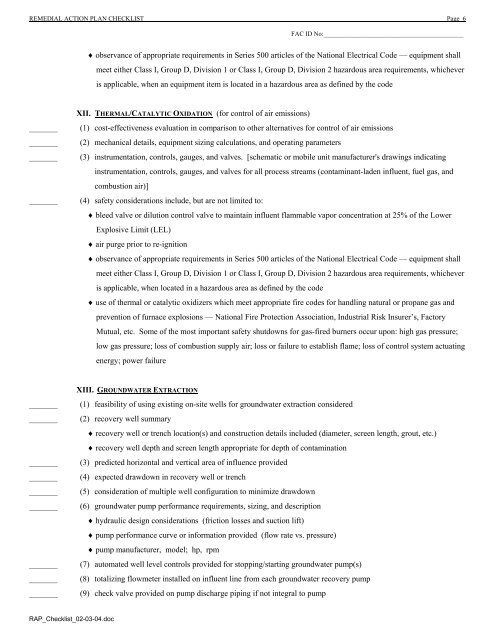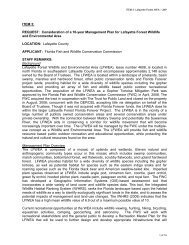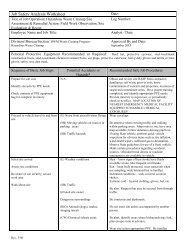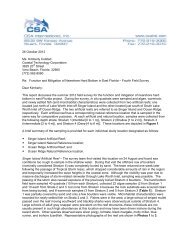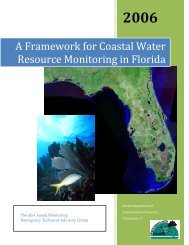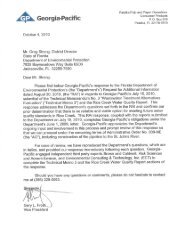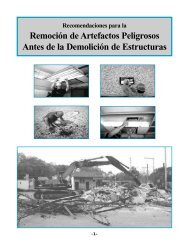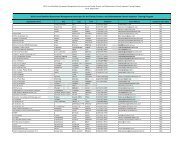Remedial Action Plan checklist - Florida Department of ...
Remedial Action Plan checklist - Florida Department of ...
Remedial Action Plan checklist - Florida Department of ...
You also want an ePaper? Increase the reach of your titles
YUMPU automatically turns print PDFs into web optimized ePapers that Google loves.
REMEDIAL ACTION PLAN CHECKLIST Page 6<br />
RAP_Checklist_02-03-04.doc<br />
FAC ID No:___________________________________________<br />
♦ observance <strong>of</strong> appropriate requirements in Series 500 articles <strong>of</strong> the National Electrical Code — equipment shall<br />
meet either Class I, Group D, Division 1 or Class I, Group D, Division 2 hazardous area requirements, whichever<br />
is applicable, when an equipment item is located in a hazardous area as defined by the code<br />
XII. THERMAL/CATALYTIC OXIDATION (for control <strong>of</strong> air emissions)<br />
_______ (1) cost-effectiveness evaluation in comparison to other alternatives for control <strong>of</strong> air emissions<br />
_______ (2) mechanical details, equipment sizing calculations, and operating parameters<br />
_______ (3) instrumentation, controls, gauges, and valves. [schematic or mobile unit manufacturer's drawings indicating<br />
instrumentation, controls, gauges, and valves for all process streams (contaminant-laden influent, fuel gas, and<br />
combustion air)]<br />
_______ (4) safety considerations include, but are not limited to:<br />
♦ bleed valve or dilution control valve to maintain influent flammable vapor concentration at 25% <strong>of</strong> the Lower<br />
Explosive Limit (LEL)<br />
♦ air purge prior to re-ignition<br />
♦ observance <strong>of</strong> appropriate requirements in Series 500 articles <strong>of</strong> the National Electrical Code — equipment shall<br />
meet either Class I, Group D, Division 1 or Class I, Group D, Division 2 hazardous area requirements, whichever<br />
is applicable, when located in a hazardous area as defined by the code<br />
♦ use <strong>of</strong> thermal or catalytic oxidizers which meet appropriate fire codes for handling natural or propane gas and<br />
prevention <strong>of</strong> furnace explosions — National Fire Protection Association, Industrial Risk Insurer’s, Factory<br />
Mutual, etc. Some <strong>of</strong> the most important safety shutdowns for gas-fired burners occur upon: high gas pressure;<br />
low gas pressure; loss <strong>of</strong> combustion supply air; loss or failure to establish flame; loss <strong>of</strong> control system actuating<br />
energy; power failure<br />
XIII. GROUNDWATER EXTRACTION<br />
_______ (1) feasibility <strong>of</strong> using existing on-site wells for groundwater extraction considered<br />
_______ (2) recovery well summary<br />
♦ recovery well or trench location(s) and construction details included (diameter, screen length, grout, etc.)<br />
_______<br />
♦ recovery well depth and screen length appropriate for depth <strong>of</strong> contamination<br />
(3) predicted horizontal and vertical area <strong>of</strong> influence provided<br />
_______ (4) expected drawdown in recovery well or trench<br />
_______ (5) consideration <strong>of</strong> multiple well configuration to minimize drawdown<br />
_______ (6) groundwater pump performance requirements, sizing, and description<br />
♦ hydraulic design considerations (friction losses and suction lift)<br />
♦ pump performance curve or information provided (flow rate vs. pressure)<br />
_______<br />
♦ pump manufacturer, model; hp, rpm<br />
(7) automated well level controls provided for stopping/starting groundwater pump(s)<br />
_______ (8) totalizing flowmeter installed on influent line from each groundwater recovery pump<br />
_______ (9) check valve provided on pump discharge piping if not integral to pump


